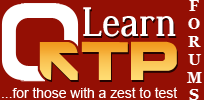When Quick Test uses the learned description to identify an object, it searches for an object that matches all of the property values in the description. In most cases, this description is the simplest way to identify the object, and, unless the main properties of the object change, this method will work.
If Quick Test is unable to find any object that matches the learned object description, or if it finds more than one
object that fits the description, then Quick Test ignores the learned description, and uses the Smart Identification
mechanism to try to identify the object.
While the Smart Identification mechanism is more complex,it is more flexible. Therefore, if configured logically, a Smart Identification definition can probably help Quick Test identify an object, if it is present, even when the learned
description fails.
The Smart Identification mechanism uses two types of properties:
Base Filter Properties: The most fundamental properties of a particular test object class; those whose values cannot
be changed without changing the essence of the original object. For example, if a Web link's tag was changed from
<A> to any other value, you could no longer call it the same object.
Optional Filter Properties: Other properties that can help identify objects of a particular class. These properties
are unlikely to change on a regular basis, but can be ignored if they are no longer applicable.
The below address of an example may help you understand better, if you don't have the guide ill post the example.
Smart Identification Example: (Ref. Quick Test Professional 9.0 – Help Guide)
If Quick Test is unable to find any object that matches the learned object description, or if it finds more than one
object that fits the description, then Quick Test ignores the learned description, and uses the Smart Identification
mechanism to try to identify the object.
While the Smart Identification mechanism is more complex,it is more flexible. Therefore, if configured logically, a Smart Identification definition can probably help Quick Test identify an object, if it is present, even when the learned
description fails.
The Smart Identification mechanism uses two types of properties:
Base Filter Properties: The most fundamental properties of a particular test object class; those whose values cannot
be changed without changing the essence of the original object. For example, if a Web link's tag was changed from
<A> to any other value, you could no longer call it the same object.
Optional Filter Properties: Other properties that can help identify objects of a particular class. These properties
are unlikely to change on a regular basis, but can be ignored if they are no longer applicable.
The below address of an example may help you understand better, if you don't have the guide ill post the example.
Smart Identification Example: (Ref. Quick Test Professional 9.0 – Help Guide)





